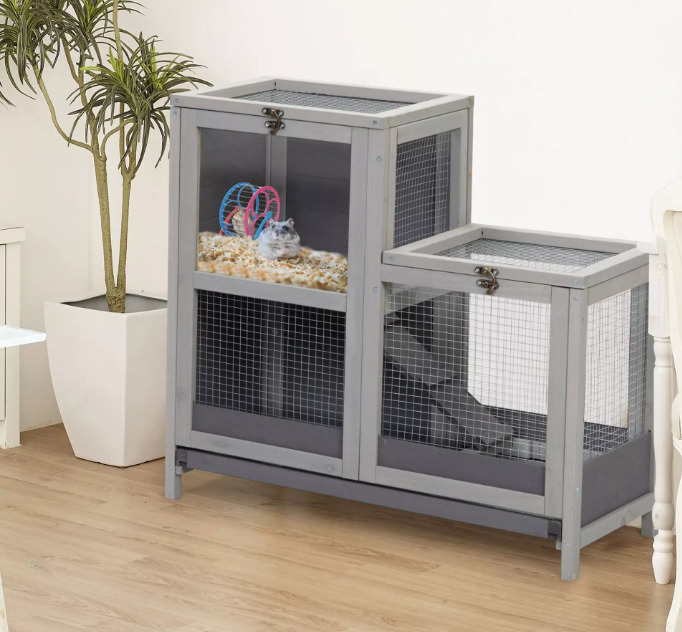When it comes to small, adorable pets, pet hamster is right up there on the list. These tiny bundles of fur have captivated pet lovers for generations with their charming antics and endearing personalities. In this article, we’ll take a deep dive into the world of pet hamster behavior and habits when they are in the hamster cage, shedding light on what makes these little creatures so delightful and intriguing to observe.
Nocturnal Activity in Hamster Cages
Nocturnal Explorers
Hamsters are known for their nocturnal behavior, meaning they are most active during the night. This behavior is a result of their natural adaptation to desert environments. Observing your hamster’s nighttime activities can be a delightful experience, as they scurry around, explore their hamster cages, and even enjoy a midnight snack.
Hibernation Instincts
Hamsters have a natural hibernation instinct that is more pronounced in the wild due to temperature fluctuations. However, in captivity, the temperature is usually controlled, and pet hamster doesn’t typically hibernate. It’s important to maintain a consistent and warm hamster cage to prevent triggering this behavior unintentionally.
Instinctive Hoarding
Hoarding Instincts
One of the most interesting behaviors of pet hamster is their instinct to hoard food. Hamsters have pouches in their cheeks that they use to transport food to their burrows. This instinct comes from their wild ancestors who needed to store food for times of scarcity. Watching your hamster stuff its cheeks full of food and then scurry away to stash it in its bedding of hamster cages is not only adorable but also a testament to their survival instincts.
Chewing to Maintain Teeth
Hamsters have teeth that grow continuously, so they have a natural instinct to chew on various objects to keep their teeth in check. Providing safe chew toys and items like wooden blocks in hamster cages helps satisfy this instinct and prevents overgrown teeth, which can lead to health issues.

Territorial Behavior for Hamster Cages
Territorial Nature
Hamsters are territorial creatures, and they can become quite possessive of their living space. You might notice your hamster engaging in behaviors like scent marking or even trying to chase away “intruders” (including your hand) from their territory. Providing them with a safe and spacious hamster cage is essential to prevent stress-related behaviors.
Nesting Behavior
Female hamsters, especially when pregnant, exhibit nesting behavior. They’ll gather bedding materials to create a cozy nest for themselves and their upcoming litter. Providing nesting material in hamster cages, such as tissue paper or hay, allows them to engage in this maternal instinct and create a comfortable space for their babies.
Social Interaction
While hamsters are often considered solitary pets, they do exhibit social behaviors, especially when they are young. Young hamsters from the same litter can often be housed together without issue. However, as they grow older, their territorial instincts for hamster cage might kick in, and they may become less tolerant of sharing their space. It’s important to monitor their interactions and be prepared to separate them if aggression occurs.
Burrowing Instincts for Hamster Cages
Burrowing Enthusiasts
In the wild, hamsters create intricate burrows for protection and shelter. This burrowing behavior continues in domesticated hamsters, even if they don’t have to worry about predators. Providing your pet hamster with appropriate bedding materials in hamster cages allows them to indulge in this natural behavior, which can be both entertaining and comforting for them.
Communication Through Squeaks
Hamsters communicate through various sounds, with squeaking being a common vocalization. They might squeak in hamster cages when they’re excited, frightened, or even during social interactions. Understanding their vocal cues can help you interpret their emotions and respond appropriately.
Sensitive to Temperature
Hamsters are sensitive to extreme temperatures. They thrive in temperatures between 65-75°F (18-24°C). High temperatures can cause heat stress, while low temperatures can lead to health issues. Ensure their hamster cages are placed in a suitable location away from direct sunlight and drafts.

Playfulness and Curiosity for Hamster Cages
Playful and Curious
Pet hamster is naturally curious and enjoy exploring their surroundings. Introducing new toys, tunnels, and obstacles to their hamster cages can stimulate their curiosity and provide mental enrichment. You might witness them climbing, tunneling, and even rolling in their exercise balls in their quest for exploration.
Chasing and Pouncing Play
Just like cats, hamsters engage in playful behaviors that involve chasing and pouncing. You might observe your hamster darting around its hamster cage, chasing after toys or even its own tail. This playful behavior helps keep them active and entertained.
Tail Wagging Expressions
While not as pronounced as in some other animals, hamsters can exhibit tail wagging, which is often associated with excitement or curiosity. Observing this behavior can give you insights into their current emotional state and level of interest in their hamster cages.
Grooming Rituals
Hamsters are meticulous groomers. You’ll often see them using their tiny paws to clean their fur, face, and whiskers. This behavior not only helps keep them clean but also serves as a way to mark their scent and maintain a sense of familiarity within their hamster cages.
Pet hamster might be small in size, but their behaviors and habits are full of charm and intrigue. From their nocturnal escapades to their hoarding instincts and curious exploration, every aspect of their behavior tells a story of their natural instincts and survival mechanisms. As a hamster owner, observing them in hamster cages and understanding these behaviors not only deepens your connection with your furry friend but also ensures that you’re providing the best possible care for their well-being and happiness.
https://www.burgesspetcare.com/blog/hamsters/hamster-behaviour-explained/
